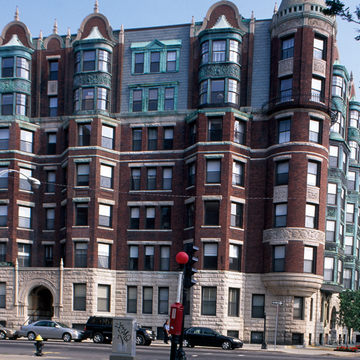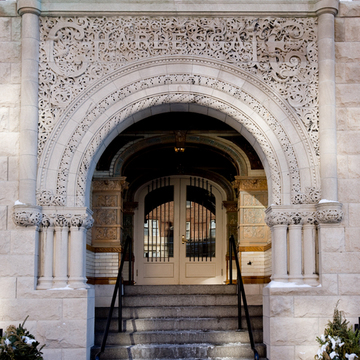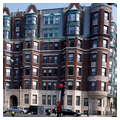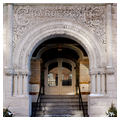A frothy pile of bays, oriels, and turrets with frontages on three streets, the Hotel Charlesgate rises above the Back Bay like the Lady of Shallot's vision of many towered Camelot. Although his own house at 277 Dartmouth/147 Newbury Street (BB30) was only a qualified success, here at last J. Pickering Putnam designed a building whose scale was commensurate with his imagination. Despite their profusion, decorative flourishes are not gratuitous accretions but, rather, natural expressions of their materials: brick and limestone; copper and slate; tile and glass. Refracting light like so many soap bubbles, the curved glass windows leaven the immense mass of the structure, as if to suggest its very monumentality is but an illusion. The hygienic glazed terra-cotta entrances and lobby, the original community dining room, and the central garden hint at the utopian motivation for Putnam's design, a cooperative apartment building inspired by Edward Bellamy's novel Looking Backward (1888) and the Nationalist Club movement it spawned. In that work, Bellamy described the future scene of Boston in the year 2000: “Every quarter contained large open squares filled with trees, along which statues glistened and fountains flashed in the late-afternoon sun. Public buildings of a colossal size and architectural grandeur unparalleled in my day raised their stately piles on every side. Surely I had never seen this city nor one comparable to it before. Raising my eyes at last toward the horizon, I looked westward. That blue ribbon winding away to the sunset—was it not the sinuous Charles?”
You are here
Hotel Charlesgate
If SAH Archipedia has been useful to you, please consider supporting it.
SAH Archipedia tells the story of the United States through its buildings, landscapes, and cities. This freely available resource empowers the public with authoritative knowledge that deepens their understanding and appreciation of the built environment. But the Society of Architectural Historians, which created SAH Archipedia with University of Virginia Press, needs your support to maintain the high-caliber research, writing, photography, cartography, editing, design, and programming that make SAH Archipedia a trusted online resource available to all who value the history of place, heritage tourism, and learning.




